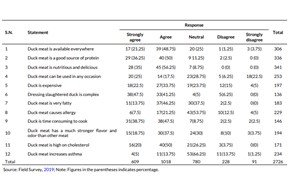A study on consumer preferences towards duck meat in Mymensingh city of Bangladesh
Abstract
This paper examined the consumer preferences of duck meat in Mymensingh city of Bangladesh. The aim of the study was to find out how much people like or dislike to consume duck meat and what amount do they consume. Purposive sampling technique was carried out among 80 consumers of duck meat. A five-point Likert scale was used to measure consumers attitudes towards duck meat and Discriminative Power (DP) value was computed to find out the lowest and the highest variability of responses. Nearly no study related to the preferences of duck meat consumption was conducted before in the selected study area. The findings of this study revealed that 63.75% consumers disfavored duck meat and 30% consumers favored it. Results indicated that the majority of the consumers strongly agreed that dressing slaughtered duck is complex and duck meat is nutritious and delicious. The highest variability in consumers responses was to statement, “duck meat can be used in any occasion. And the
lowest variability of responses was to the statement that, “duck meat is very fatty” as almost all the respondents agreed. Therefore, it can be concluded that consumers showed unfavorable attitudes towards duck meat consumption. The reason behind this disfavoring attitude were allergy, asthma and seasonal pattern of duck meat consumption. This means that the respondents showed differentiated response, when they were responding on the statement that duck meat can be used in any occasion while the respondents were somewhat in differentiated while they were responding that the duck meat is very fatty. Traditionally duck is consumed in winter season in Bangladesh. That’s why, the year-round consumer preferences including warmer seasons resulted in lower total year-round preferences.
Keywords:
Consumer, Consumption pattern, Duck, Meat, PreferenceDownloads
References
Afrin, H., Begum, R., Ahmed, M.J.U., Rahman, M.A. and Haque, S. (2016). Profitability analysis and gender division of labour in duck rearing: a case of Kishoreganj district in Bangladesh. Progressive Agriculture, 27(4): 482-489.
Begum, M., Faruque, M.O., Haque, M.A., Islam, F. and Hossain, M.S. (2018). Exploratory studies on the crossbread duck farming from two upazillas under Noakhali district in Bangladesh. Bangladesh Journal of Scientific and Industrial Research, 53(1): 47-52
Das, S.C., Yahya, M., Hasan, M.S., Hossain, M.A., Akter, T. and Sultana, M. (2018). Growth performance of white, black and bronze color heritage turkeys under semi-intensive system. Journal of the Bangladesh Agricultural University,16(3): 471-477.
Department of Livestock Services (DLS) (2019). Livestock Economy at a Glance, DLS Division of Livestock Statistics, Ministry of Fisheries and Livestock, Farmgate, Dhaka, Bangladesh.
DLS (2018). Annual report on livestock 2018. Division of Livestock Statistics, Ministry of Fisheries and Livestock, Farmgate, Dhaka, Bangladesh.
DLS (Department of livestock services) (2016). Yearly updated report for 2015-2016. Government of the People’s Republic of Bangladesh, Farmgate, Dhaka, Bangladesh. Retrieved from: http://www.dls.gov.bd.
Hossain, M.M. (1989). A comparative study on the performance of pure and cross bread ducklings under local conditions. M.Sc. Thesis Department of Poultry Science, Bangladesh Agricultural University, Mymensingh, Bangladesh.
Islam, M.N., Haque, Q.M.E., Uddin, M.S. and Sarker, M.S.K. (2003). Potentiality of Native Genotypes of Ducks. Proceedings of 3rd International Poultry Show and Seminar, Bangladesh China Friendship Conference Center, Dhaka, Bangladesh. pp. 259-270.
Jalil, M.A., Ali, A., Begum, J. and Islam, M.R. (1997). Study on the performance of different genotypes of ducks under village condition. Asian-Australasian Journal of Animal Sciences, 10(2): 192-195.
Jha, B.K. and Chakrabarti, A. (2017). Duck farming: a potential source of livelihood in tribal village, Journal of Animal Health and Production, 5(2): 39-43.
Kanagaraju, P., Ialaludeen, A. and Rathnapraba, S. (2012). An analysis on factors influencing consumption pattern of duck and duck products among people of Kerala, India. Research Journal of Poultry Sciences, 5(3): 31-35.
Keppel, G. and Zedeck, S. (1989). Data analysis for research designs: Analysis of variance and multiple regression/correlation approaches. New York: W.H. Freeman and Company.
Khanum, R. and Mahadi, M.S.A. (2015). Economic empowerment of haor women through duck farming in Bangladesh. The Agriculturists, 13(1): 18-25.
Magor, N.P. (1986). Livestock and poultry component in Small farmer development in Bangladesh – A case Study. Presented at the Crop-Livestock workshop at Khon Kaen Thailand.
Mayhew, M.J. and Simonoff, J.S. (2015). Non-White, no more: Effect coding as an alternative to dummy coding with implications for higher education researchers. Journal of College Student Development, 56(2): 170-175.
Morduzzaman, M., Bhuiyan, A.K.F.H., Rana, M., Islam, M.R. and Bhuiyan, M.S.A. (2015). Phenotypic characterization and production potentials of Nageswari duck in Bangladesh, Bangladesh Journal of Animal Science 44 (2): 92-99.
Nachmias, C.F. and Nachmias, D. (1992). Research methods in social science 4th ed. London Edward Arnold.

Published
How to Cite
Issue
Section
Copyright (c) 2020 Agriculture and Environmental Science Academy

This work is licensed under a Creative Commons Attribution-NonCommercial 4.0 International License.

